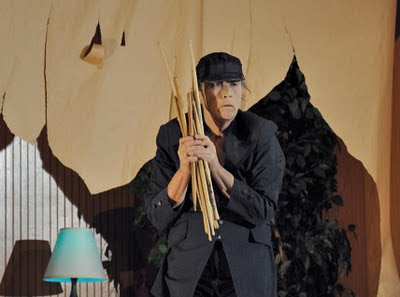by Lynnda
 |
| View looking NW towards Kobe lantern, photo by Lynnda |
I had a 12:30 public tour to lead today, and I thought I had left home in plenty of time to accommodate all the traffic snafus predicted for the day. Fortunately, I had the gatehouse phone number saved in my cell phone and had to call twice to say I was stuck in traffic, but really, I was coming! For the length of time sitting in traffic, fretting about being late,and the number of rain squalls that came and went while waiting to cross the
 |
| Doug Fir with Sapsucker holes, photo by Lynnda |
On the eastern path leading to the gardener's shed stands a Doug Fir that always intrigues me. Horizontal holes are drilled throughout the trunk. I had to ask my birder friend to identify who made these holes. Her comment: "A kind of woodpecker called a sapsucker makes those holes. They return over and over again for the sap and the bugs attracted to the holes! Other birds including hummingbirds also drink the sap!" There are 3 uncommon species in our area and one common species, Red-breasted Sapsucker, according to The Sibley Field Guide to Birds of Western North America.
As we walked around the garden, we were met with showers, torrents, sun shine and blue skies. All within one hour! There were ducks fighting with each other and with the koi, each trying to be the first to the fish food. I was heartened to see some small koi still darting out from under the lilly pads. Earlier this summer, I noticed their mouths weren't large enough for the small pellets of food. They are now large enough to scoop up the food, but there are many fewer than a month ago. Missing were sightings of all the turtles. They must not have enjoyed the changing weather conditions!
 |
| Saucer Magnolia in Bloom, Photo by Lynnda |
What a surprise to see a brightly colored bloom on the Saucer Magnolia (Magnolia x soulangeana) near the eastern wall. Are the seasons confused?
 |
| Burning Bush, photo by Lynnda |
There were signs that fall is approaching. The Burning Bush or Winged Spindle Tree (Euonomus alata) is beginning to turn colors. In a few more weeks, in time for the Maple Viewing Event (Oct. 16, 2011), the leaves should be a rich, dark red color. Also beginning to change color are the leaves of the Korean Dogwood (Cornus kousa 'Chinensis'). The Ginko leaves are still green, so I'll have to come back in a few weeks to see their radiant golden color.
 |
| Korean Dogwood, photo by Lynnda |
Visitors to the Garden from now to the close in November will see an evolving picture of autumn colors. Each week will showcase added colors. Be sure to come visit often. Some of my most peaceful visits have been in the fall when there's light misting. Come and see for yourself!













